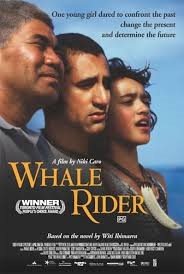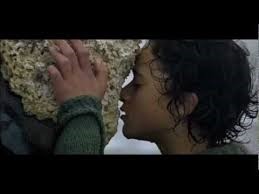Greeting the Whale – A Posture to Depth Body Work
 I saw a beautiful movie the other day called Whale Rider. Naturally I was drawn to the title. The movie had a mythological quality to it – rich in metaphor for the healing journey. I get excited when a piece of art moves me on this level. Each character resonates with a part of me and, as I watch them work through conflicts on the screen, I learn lessons on how to deal with my own conflicts. There is one scene in particular that struck me. Before I go into the scene it is important to provide some background information about the story. (If you have not seen the movie, spoiler alert ahead.)
I saw a beautiful movie the other day called Whale Rider. Naturally I was drawn to the title. The movie had a mythological quality to it – rich in metaphor for the healing journey. I get excited when a piece of art moves me on this level. Each character resonates with a part of me and, as I watch them work through conflicts on the screen, I learn lessons on how to deal with my own conflicts. There is one scene in particular that struck me. Before I go into the scene it is important to provide some background information about the story. (If you have not seen the movie, spoiler alert ahead.)
In the east coast of New Zealand, the tribe chief of the Whangara people is Koro. Traditionally, leadership is passed to the first born son of the chief. Koro’s son however has refused this position, and eventually left the village after a tragedy where his wife gave birth to twins – a boy and girl – but the boy died during the pregnancy. This left the story’s protagonist, Pai, the granddaughter of Koro, as the only remaining child in line for leadership. However, because of her gender she is ineligible. Koro is bitterly disappointed. His relationship with Pai is conflicted. On one level he blames Pai for the tragedy and rejects her as leader despite evidence to the contrary. At the same time, he also develops an affectionate relationship with her.
The Whangara tribe is wounded. With the young adults drowning their pain in alcohol, the community’s vitality is wasting away. Koro knows he is failing, yet he is sincere in his hopes to inject a sense of dignity and meaning into his community. He feels that finding the next chief amongst the males will save his community from the clutches of apathy. Koro is trapped by tradition. It gives him the strength to value the sacred but also blinds him from seeing that Pai is the ideal leader of the community. The rules of the past prevent him from seeing what is vital in the present.
This is not the case with Pai. She is connected to the essence of her tradition, but not limited by the rules. She knows that according to legend the tribe’s oldest ancestor, Paikea, was saved from drowning by a great whale, and it is to the whales that she calls for help. They respond to her call late one night, but not as she expected. The whales arrive and beach themselves on the shore. Koro and Pai both know that the biggest whale is Paikea’s whale and they understand that the manner of his arrival is a message that the community is in great trouble.
Koro’s pain at seeing the whale of his ancestor struggling to survive is palpable. In response he gets the community to try to push Paikea’s whale back into the ocean. He believes that if this is achieved the other whales will follow. They even try to use a tractor to pull the whale back into the ocean but to no avail. The whales will not budge.
 After the tribe has given up, Pai takes a different approach. She slowly walks toward Paikea’s whale and with great care and sensitivity she greets it. First by gently touching it and then with the traditional and intimate greeting of the tribe – forehead to forehead, nose to nose. She closes her eyes as she connects to the great beast. Her face depicts her profound compassion and empathy for the animal and indirectly for the state of her community. She holds this depth as she connects, taking her time with this most sacred greeting. Patiently, and when the time is right she climbs upon the beast, her feet feeling the whale beneath her. This is done with the utmost respect. She whispers to the whale and it responds. Up until this point the whales had not moved, but her willingness to connect – not just push the beast back into the ocean – creates a shift.
After the tribe has given up, Pai takes a different approach. She slowly walks toward Paikea’s whale and with great care and sensitivity she greets it. First by gently touching it and then with the traditional and intimate greeting of the tribe – forehead to forehead, nose to nose. She closes her eyes as she connects to the great beast. Her face depicts her profound compassion and empathy for the animal and indirectly for the state of her community. She holds this depth as she connects, taking her time with this most sacred greeting. Patiently, and when the time is right she climbs upon the beast, her feet feeling the whale beneath her. This is done with the utmost respect. She whispers to the whale and it responds. Up until this point the whales had not moved, but her willingness to connect – not just push the beast back into the ocean – creates a shift.
The great whale moves its large fin, stirring the ocean’s waters. The other whales of the pod retreat into the water and Paikea’s whale begins to recede as well, taking Pai with it. Pai surrenders to the beast. Into the ocean she goes. Her community fears that she will die and begins to mourn. But Pai does not die. Instead, she comes back with the wisdom and the vitality to heal her community. When she returns, the tribe comes together, united and stronger than ever before. The men and women of the tribe have awoken from their slumber and Pai sits as the rightful leader.
Pai’s greeting with the whale is a powerful scene and can be found in this video:
Here we have two sincere individuals – Koro and Pai. Both want what is best for their community. Both are looking for answers to the pain they witness. And yet, when the answers start to come forward – when whales of their ancestors mirror the state of their community struggling to survive – Koro orders the tribe to push the whales back underwater.
This is a reaction that many of us can relate to. When we become aware of our suffering, the first thing we want to do is get rid of it. The pain, the anxiety, or our past trauma bubbling up inside of us – not many of us want to feel these things. Why should we? It can be scary; we don’t know what is behind the sensations we are starting to feel nor the myriad of emotions that can accompany them. We just know that it is uncomfortable. And yet, the feelings trickling up inside of us are our body’s way of drawing our attention to the healing that needs to take place. We must understand that behind this discomfort is a gentle friend of ours, sharing a burden it can no longer carry in silence. This is the whale beached on the shore of our consciousness. And it is waiting to know what we will do with it now that we are aware of its presence.
We could push our whale back into the ocean. Perhaps, this may even work for some time. But eventually, when healing becomes critical for our lives, the whale will not budge no matter how many quick fixes we try. It is time for a new approach – one that honours the sacredness of the reunion that needs to take place. Our bodies have come to share, and we must greet them as Pai greeted Paikea’s whale. This means not pushing or running away from our discomfort, but instead communicating to our body that we are ready to connect with it in humility and mutual respect. To feel it with all our senses. To stand vulnerable before it, as it has stood vulnerable before us.
This may sound scary, but with the right preparatory work we develop a trust that our body knows how to heal when we give it the space. In every way, we can let our body know: “I’m listening now.” When we adopt this posture of openness, allowance and respect towards our body, it will invite us to travel with it into our depths. It will share the story behind these uncomfortable sensations and our pain. This is the story we yearn to hear because it is in knowing the story that the healing we long for can occur. The body that would not budge will begin to shift when it knows that we are here to sit with it patiently.
This is where we begin to realize a great irony of depth healing. When we are willing to follow our pain, we end up gaining access to the joy and vitality that is locked behind it. When we honour the story of our past, we will gain access to the inner strength and resilience we need to build our future. Though our body may start by sharing uncomfortable sensations, when we build a relationship to it, it will soon show us the many treasures buried in our sea. The treasures come in the form of wonderful reunions with abandoned parts of our personality, penetrating insights, and access to the resources that will help us meet life’s challenges authentically. These are the boons of the journey towards health and wholeness. Each can be brought back ashore to enrich our lives and our precious relationships.
The healing journey is an exciting one. It demands great courage but it gifts greater reward. To that wonderful moment in your life when the whale will not budge, to the greeting you will make and to the treasures you will uncover under the sea.
Satyam Malhotra